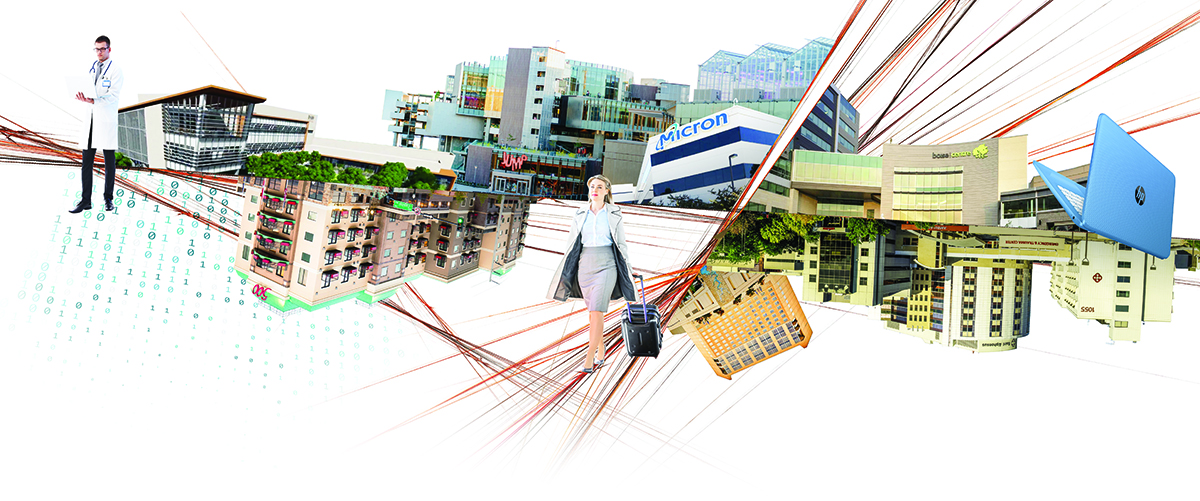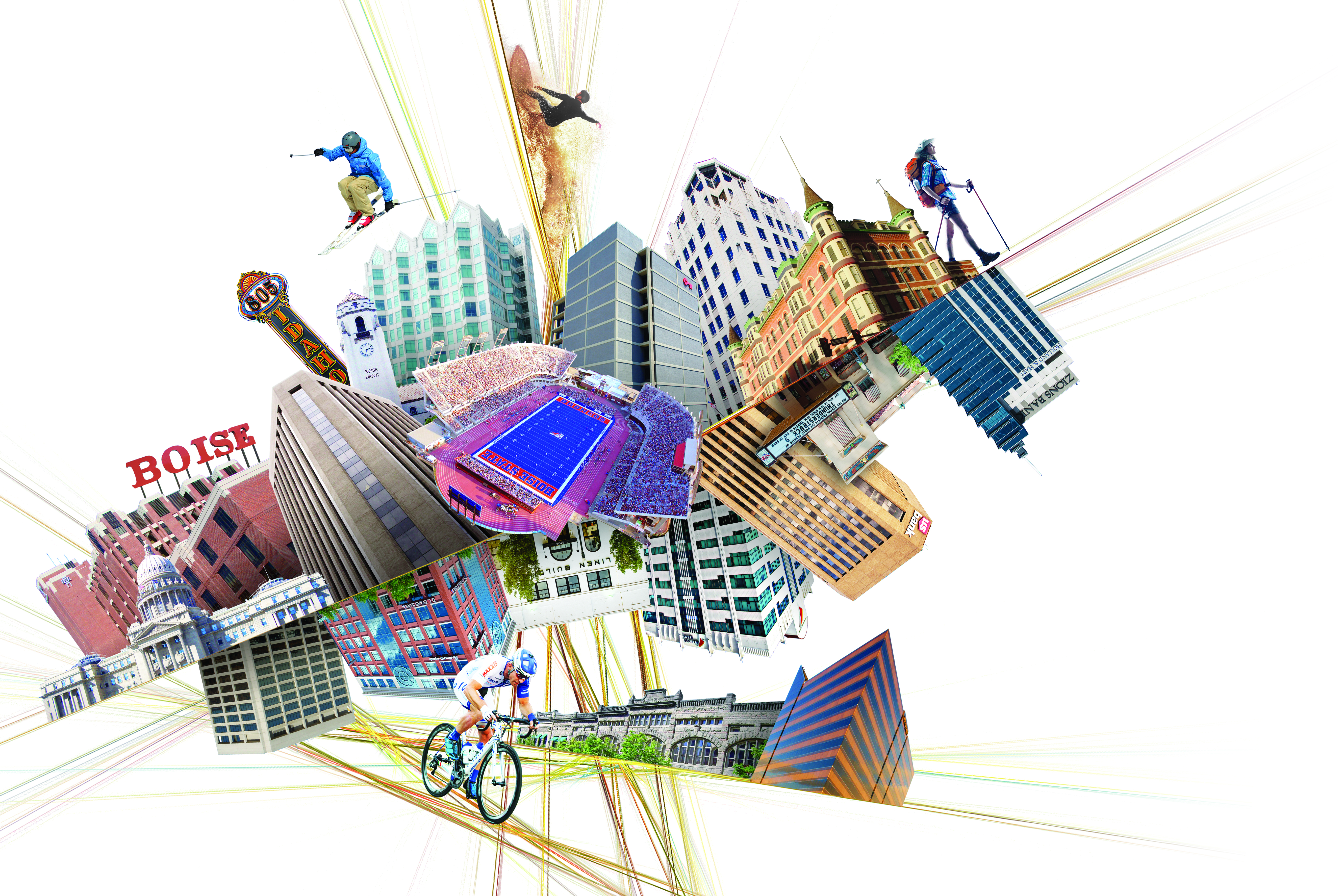Vogue dubbed it a “culinary hotspot.” Forbes continues to place it in the top ranks of the nation’s fastest growing cities.
U.S. News & World Report touted it as one of the top 10 places to live in the United States.
Boise has found its sweet spot.
In the company of notable cities like Denver, Colo.; Austin, Texas; and Portland, Ore.; the capital city that makes up just over a third of the state’s population is attracting new business and new residents while retaining its current populace and small-town appeal, thanks to its laidback lifestyle and access to nearby recreation, coupled with big city amenities.
“The next 20 years in Boise is the absolute golden point because of the access to recreation, access to other business leaders, access to the capital and the Legislature, and quality of life,” says Clark Krause, the executive director of the Boise Valley Economic Partnership (BVEP).
“The city has reached a size right now that is sustainable, and we are not seeing a lot of growing pains yet. It is incredibly easy to access recreation, business leaders, buildings, the churches, schools, all of those things. There is magic in that.”
The Numbers
Across Idaho, the annual average population growth is 1.4 percent, according to the Idaho Department of Labor. In Boise, it’s 1.9 percent. Within that growth, Boise is welcoming a younger sector to the population looking for opportunities, like starting businesses and raising a family; 14.2 percent are within the ages of 25 to 34 and 13.7 percent are 35 to 44. What’s more, a third of the city’s population holds an advanced degree.
“We are in the center of the fastest growing region in the country,” says Robert Spendlove, the economic and public policy officer of Zions Bank. “More people are moving to the Intermountain West than anywhere else.”
To quantify this increase, Spendlove looks to the net migration of Idaho: the number of people moving into the state minus the number moving out. “This is a strong indicator of your overall economic strength relative to other areas,” he says.
In 2012, Idaho’s net migration was 1,200 people. By 2015, it jumped to 9,000 and then in 2016, it sky-rocketed to 18,869.
“People are hearing the story and getting excited,” Spendlove says. Boise garners a significant impact from these numbers, because it holds court as the largest city in the state and is the urban center.
So, why the buzz?
The Industry
This uptick in considering Boise as a key player on a national stage has many components. Krause points to the business climate. At one time, Boise was the home of seven Fortune 500 companies, a testament to the possibility for other large-scale corporations to succeed in the modest metro. Today, four national businesses still call Boise home, including semiconductor and flash memory drive producer Micron; grocery store chains Albertsons and WinCo Foods; and food supplier Simplot.
“The success of these businesses tells the story that new businesses should feel confident they can make it here,” Krause says.
Throughout industries in Boise, BVEP has noted
a growth in tech manufacturing, trade, transportation, utilities jobs, and tourism. A number of niche tech startups have begun to pepper the economic landscape of Boise, too. But most notably, education and health services have grown 33 percent since 2006.
“Healthcare is by far one of the biggest growing segments in Boise,” Krause says. “That is not unique to us, but it has been interesting to watch our two major hospitals invest a lot of money into the marketplace. This growth has gone west toward Nampa, Meridian, and spread throughout the Valley.”
The reason? Some would look to the push to fix the physician shortage across Idaho, where there are only 1.7 doctors for every 1,000 residents, the second lowest rate in the nation, just above that of Mississippi. Boise’s suburb Meridian is answering this doctor draught by breaking ground on Idaho’s first medical school: Idaho College of Osteopathic Medicine, an affiliate of Idaho State University, slated to open in fall 2018.
But beyond the medical sector, Idaho also boasts a deep-seated relationship with the food industry, from its acres and acres of farmland to food producers based in the Gem State. Boise gives food manufacturers an up-close look at the connection between agricultural and high-density populations and feeding the masses. To Krause, this gives Boise a unique lens.
“The incredible history of food in Idaho, as a whole, is important to our story, but when you look at the need for technology that goes along with food, Boise also has that,” he says. “To have Simplot means we have a huge anchoring company that is well-known throughout the world as this global force in food and is very interested in how we answer feeding people in America and the world.”
 The Draw
The Draw
But the buck doesn’t stop with the economic climate: Boise is also a destination for business and pleasure.
The vibrant downtown boasts 100 restaurants and bars within a six-block stretch. The city continues to receive accolades as a top culinary destination in the West, with nods given to its craft beer and winery scene.
“Tourism is the economic gateway drug, as we say, or a first date with a community,” says Carrie Westergard, the executive director of the Boise Convention & Visitors Bureau.
Westergard and her team at the CVB have watched as downtown quickly sprouted new hotels (four in the past two years), restaurants, and amenities to accommodate a growing demand, a much-needed addition.
“We were behind the eight ball as far as attracting big conventions and groups, because we were short in available hotel rooms in the downtown,” Krause says. “There was some catch up that needed to be done.”
And catch up, they did, in the form of a $47.5 million multi-phase expansion to the Boise Centre Meeting and Conventions, increasing the once 50,000-square-foot facility with 18 meeting rooms to an 86,000-square-foot space with 31 meeting rooms and flexible event space.
According to the CVB, Boise has experienced a 10 percent growth to date in revenue from overnight stays; 1.6 million hotel rooms are rented each year.
“We’ve had one full year for the new space, and they just opened the remodeled space,” says Westergard. The CVB partnered with Boise Centre as a marketing partner. “We were able to host our first and largest city-wide convention in June.”
During this conference, Boise Centre hosted
1,500 people with Council State Territorial Epidemiologists, CSTE, the largest national conference for epidemiologists.
“The event filled every single bit of the new space and the existing space and overflowed into more hotel spaces. It took 12 hotels to host everyone. It wouldn’t have happened without the expanded space,” Westergard says.
The first phase of the expansion, Boise Centre East, opened in September 2016 and the additional rooms helped Boise Centre increase the total number of events by 23 percent over the prior year, according to Mary-Michael Rodgers, the communications manager at Boise Centre.
But the impact runs deeper than putting heads in beds. A study by Boise State University found that conference attendees average $277 a day in local spending, compared to $77 for locals.
“In 2016, Boise Centre generated $22.3 million in local economic benefit. Spending by visitors attending events at Boise Centre also led to an additional $723,000 in state sales tax collections,” she says. “The economic impact of Boise Centre on the local economy is projected to double by the year 2023.”
Beyond the numbers, the ability to host national conferences will continue to give Boise some skin in the game, welcoming visitors who could become residents, bringing businesses along with them.
Sustaining the Sweet Spot
The same thing that attracts attention to the capital city—beautiful surroundings, recreation, and open space—is exactly what the city and its residents hope to sustain, but staying in the sweet spot of positive growth, while keeping the cost of living affordable and maintaining the region’s original character, is a constant struggle.
“City leadership has really been attuned to the right growth,” Krause says.
This can be seen, he explained, in Boise’s efforts towards preserving the foothills and surrounding open space. In 2015, voters overwhelming passed a levy to raise $10 million through property taxes earmarked for the conservation benefits. The initiative began with a 2001 levy that helped preserve 10,750 acres for wildlife, recreation, and clean water.
“There is wonderful green space and parks that are along the river and will remain, rather than putting high rises and housing,” Krause says. “They have done a good job of protecting those things you would never want to lose here.”
While other questions of traffic congestion and cost of living are a given with growth, Krause echoes the effort for thoughtfulness.
“Will it get more expensive? Yes, you will see some prices escalate, but they won’t escalate at the rate you see in Portland, Seattle, or Austin,” he says.
Boise holds steadfast to its charm and character—amazing restaurants, unbeatable wilderness access, and an attractive business climate—but the once sleepy mid-sized city has found its seat at the table.
“There is just something about this place and the people here,” Krause says.

